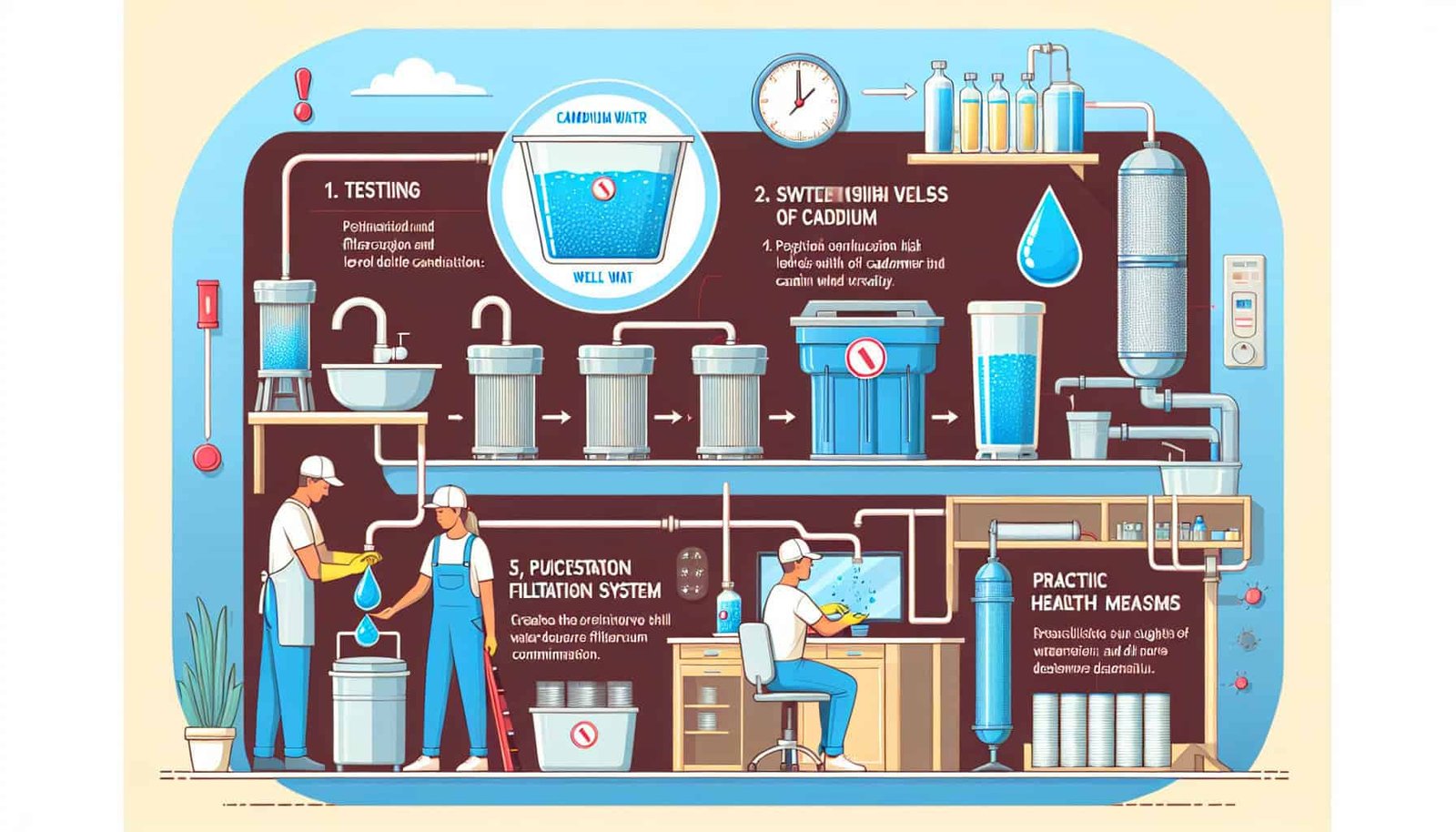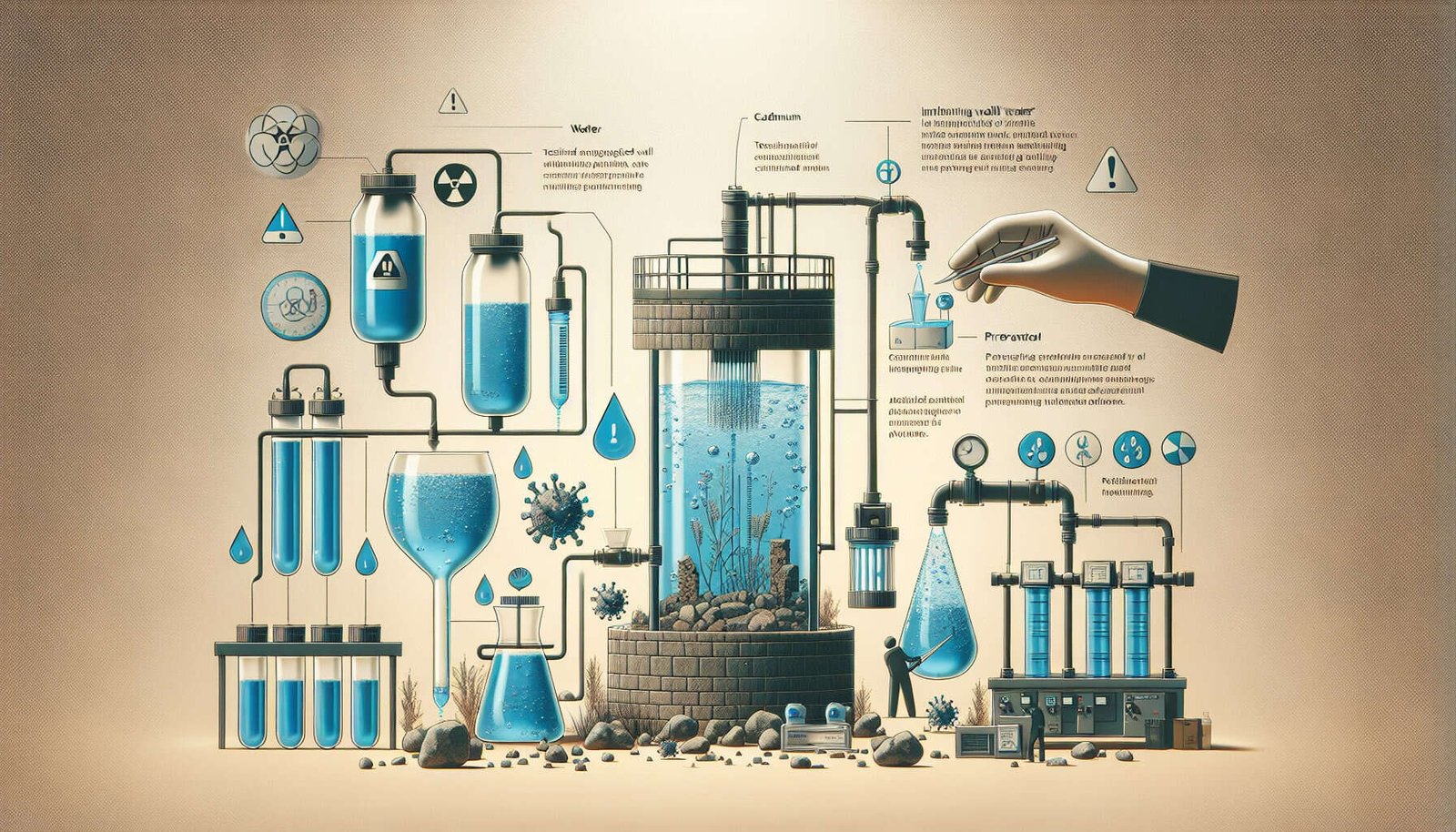Have you ever wondered how to effectively maintain well water that contains high levels of cadmium? If you’re facing this challenge, fret not! This article aims to provide you with practical and efficient solutions to ensure the safe use and preservation of your well water. We will explore various methods and techniques that will help you combat the presence of cadmium, keeping your water clean and suitable for consumption. Say goodbye to your worries and let’s dive into the world of maintaining well water with high levels of cadmium!
Understanding Cadmium Contamination
Cadmium contamination in well water can pose significant health risks if not properly addressed. It is important to understand the sources of cadmium contamination, the potential health effects of exposure, and how to test well water for cadmium levels.
Sources of Cadmium Contamination
Cadmium can enter well water through various sources, including industrial activities, agricultural practices, and natural deposits. Industrial activities such as mining, manufacturing, and waste disposal can release cadmium into the environment, which can then seep into groundwater and contaminate well water. Agricultural practices, including the use of fertilizers and pesticides containing cadmium, can also contribute to contamination. Additionally, natural deposits of cadmium present in soil and rocks can dissolve into groundwater and end up in wells.
Health Effects of Cadmium Exposure
Exposure to high levels of cadmium can have detrimental effects on human health. Cadmium is a toxic heavy metal that accumulates in the body over time. Prolonged exposure to cadmium can lead to kidney damage, lung and prostate cancer, and skeletal damage. It can also affect the cardiovascular, respiratory, and reproductive systems. It is therefore crucial to minimize cadmium exposure by reducing contamination in well water.
Testing Well Water for Cadmium Levels
Regular testing of well water for cadmium levels is essential to ensure its safety. There are various methods available to test for cadmium, including laboratory analysis and home testing kits. Laboratory analysis provides accurate results and can detect even low levels of cadmium, but it may require professional assistance and can be costly. Home testing kits are more convenient and cost-effective but may have limitations in detecting lower levels of contamination. It is important to follow the testing guidelines provided and take appropriate action based on the results.
Reducing Cadmium in Well Water
To reduce cadmium contamination in well water, it is important to identify the source of contamination, prevent further contamination, and consider water treatment options.
Identifying the Source of Cadmium
Identifying the source of cadmium contamination is crucial in effectively addressing the issue. Conducting a thorough assessment of the surrounding environment, including nearby industrial activities, agricultural practices, and potential natural sources, can help identify the potential sources of contamination. Additionally, understanding the geological characteristics of the area can provide insights into the presence of natural deposits of cadmium.
Preventing Cadmium Contamination
Preventing further cadmium contamination in well water is essential to ensure long-term water quality. Implementing best practices in industrial and agricultural activities can help minimize cadmium release into the environment. This includes proper waste management, responsible use of fertilizers and pesticides, and adherence to regulations. Implementing erosion control measures and maintaining proper drainage systems can also prevent the leaching of cadmium from soil into groundwater.
Water Treatment Options
Various water treatment options are available to remove or reduce cadmium levels in well water. These include activated carbon filtration, ion exchange, reverse osmosis, distillation, and electrochemical treatment. Activated carbon filtration is effective in removing organic compounds and some heavy metals, including cadmium. Ion exchange involves replacing cadmium ions with less harmful ions, such as sodium or potassium ions. Reverse osmosis uses a membrane to remove contaminants, including cadmium. Distillation involves boiling water and collecting the vapor, leaving behind contaminants. Electrochemical treatment involves the use of electrodes to remove cadmium ions from water. Each treatment option has its own advantages and considerations, and it is important to consult professionals to determine the most suitable method for specific situations.

Removing Cadmium from Well Water
If well water has already been contaminated with cadmium, it is crucial to take steps to remove it effectively. Several treatment methods can help in removing cadmium from well water.
Activated Carbon Filtration
Activated carbon filtration is an effective method to remove cadmium from well water. The activated carbon has a high surface area that allows for adsorption of cadmium ions, effectively trapping them and preventing them from entering the drinking water. Regular maintenance and replacement of the activated carbon filter are essential to ensure its continued effectiveness.
Ion Exchange
Ion exchange is another method that can be used to remove cadmium from well water. In this process, cation exchange resin is employed to replace cadmium ions with less harmful ions, such as sodium or potassium. This technique effectively reduces cadmium levels in water, but periodic regeneration or replacement of the resin may be necessary to maintain its efficiency.
Reverse Osmosis
Reverse osmosis is a widely used method for removing various contaminants, including cadmium, from well water. It works by forcing water through a semipermeable membrane, effectively trapping and removing any cadmium particles or ions present. Regular maintenance and replacement of the membrane are important to ensure optimal performance.
Distillation
Distillation involves evaporating water and then condensing the vapor to remove contaminants, including cadmium. This method effectively separates cadmium from the water, as the vapor collected is free from contaminants. However, it is energy-intensive and may not be suitable for large-scale water treatment.
Electrochemical Treatment
Electrochemical treatment is a newer technology that can be used to remove cadmium from well water. This method utilizes electrodes to attract and remove cadmium ions from the water. Regular monitoring of the electrodes and adjustment of the treatment process are necessary to ensure its effectiveness.
Maintaining Water Quality
Maintaining water quality is essential to ensure the safety and purity of well water. Regular testing and monitoring, proper cleaning and maintenance of filtration systems, changing filters and media, ensuring adequate water flow, and periodic professional maintenance all play crucial roles in maintaining water quality.
Regular Testing and Monitoring
Regular testing and monitoring of well water are vital to detect any potential contamination, including cadmium. It is recommended to test well water at least once a year for cadmium and other contaminants. Additionally, monitoring water quality parameters such as pH, hardness, and turbidity can provide insights into the overall condition of the water.
Proper Cleaning and Maintenance of Filtration Systems
If water treatment systems such as activated carbon filtration, ion exchange, or reverse osmosis are installed to remove cadmium, proper cleaning and maintenance are essential. This includes regular backwashing, cleaning or replacing filters or membranes, and disinfection. Following manufacturer instructions and guidelines is important to ensure the proper functioning of the filtration systems.
Changing Filters and Media
Filters and media used in water treatment systems have a limited lifespan and effectiveness. It is crucial to regularly change or replace filters and media to maintain their efficiency in removing cadmium and other contaminants. It is recommended to follow manufacturer recommendations and schedule routine replacements to ensure consistent water quality.
Ensuring Adequate Water Flow
Adequate water flow is crucial in maintaining water quality in well systems. Slow or stagnant water flow can lead to the growth of bacteria and other microorganisms, compromising water quality. Regular well maintenance, including checking and cleaning screens and pipes, can help ensure adequate water flow.
Periodic Professional Maintenance
Periodic professional maintenance of well systems and water treatment equipment is important to address any potential issues and ensure optimal performance. Engaging qualified professionals for routine inspections, repairs, and maintenance can help detect and resolve problems early on and prevent further contamination or system failures.

Protecting Your Health
Protecting your health is of utmost importance when dealing with cadmium contamination in well water. Following recommended health guidelines, minimizing skin contact with contaminated water, and considering alternative water sources are essential steps to protect yourself and your loved ones.
Following Recommended Health Guidelines
It is important to follow recommended health guidelines to minimize exposure to cadmium-contaminated well water. This includes avoiding drinking or using the contaminated water for cooking, brushing teeth, or preparing baby formula. Limiting exposure to contaminated water should be a priority to minimize health risks.
Minimizing Skin Contact with Contaminated Water
Cadmium can be absorbed through the skin, so minimizing skin contact with contaminated water is crucial. This includes avoiding bathing or showering with the contaminated water and wearing protective gloves when handling the water for any purpose. Minimizing skin contact can reduce the risk of cadmium absorption into the body.
Considering Alternative Water Sources
If the cadmium contamination in well water is persistently high or difficult to remove, considering alternative water sources may be necessary. This can include using bottled water for drinking and cooking or exploring community water supply options. Seeking advice from local health and environmental authorities can help in making informed decisions regarding alternative water sources.
Regulatory Compliance
Understanding applicable regulations and adhering to safe drinking water standards is important when dealing with cadmium contamination in well water. Complying with regulations ensures both the legal and safe operation of well systems and water treatment processes.
Understanding Applicable Regulations
Familiarizing yourself with the relevant local, state, and federal regulations regarding well water and cadmium contamination is crucial. This includes understanding the permissible cadmium levels in drinking water and the requirements for well construction, operation, and maintenance. Staying informed about the regulations can help ensure compliance and the safety of the well water.
Adhering to Safe Drinking Water Standards
Adhering to safe drinking water standards not only ensures regulatory compliance but also guarantees the quality and safety of well water. Safe drinking water standards set permissible levels for various contaminants, including cadmium. Monitoring and treating well water to meet these standards is essential to protect public health and ensure the purity of the water.
Seeking Professional Assistance
Navigating through the regulatory landscape and ensuring compliance can be complex. Seeking professional assistance from water quality experts, environmental consultants, or local health authorities can provide valuable insights and guidance in meeting regulatory requirements. These professionals can provide expert advice specific to the local area and help ensure compliance with applicable regulations.

Educational and Outreach Efforts
Raising awareness of cadmium contamination, providing information to local communities, and supporting research and advocacy initiatives are important steps in addressing the issue on a broader scale.
Raising Awareness of Cadmium Contamination
Raising awareness about the dangers of cadmium contamination in well water is crucial to ensure community understanding and participation. Conducting public awareness campaigns, distributing educational materials, and organizing community events can help spread important information about cadmium and its potential health effects. Raising awareness can empower individuals and communities to take action and protect their water sources.
Providing Information to Local Communities
Providing accurate and accessible information to local communities is vital in promoting informed decision-making and action. This includes educating individuals about the sources of cadmium contamination, potential health effects, testing and treatment options, and preventive measures. Collaborating with local health departments, environmental organizations, and community groups can help in disseminating information effectively.
Supporting Research and Advocacy Initiatives
Supporting research and advocacy initiatives can contribute to a better understanding of cadmium contamination and its impacts. Funding and participating in scientific research projects can help uncover new insights and solutions. Supporting advocacy efforts that focus on raising awareness, promoting policy changes, and improving water management practices can lead to long-term improvements in addressing cadmium contamination.
Building Community Partnerships
Engaging with local water authorities, collaborating with environmental organizations, and forming community action groups can foster collective efforts in addressing cadmium contamination and ensuring water safety.
Engaging with Local Water Authorities
Engaging with local water authorities is crucial in addressing cadmium contamination at the community level. Collaborating with these authorities can help facilitate regulatory compliance, knowledge sharing, and access to resources. It can also ensure effective communication and coordination among different stakeholders involved in water management and protection.
Collaborating with Environmental Organizations
Collaborating with environmental organizations can provide valuable expertise and resources in tackling cadmium contamination. These organizations often have extensive knowledge in environmental issues, community engagement, and advocacy. Partnering with them can strengthen community-driven initiatives and enhance the capacity to address cadmium contamination systematically.
Forming Community Action Groups
Forming community action groups can mobilize and empower individuals within affected communities to address cadmium contamination collectively. These groups can facilitate knowledge sharing, organize community events, and advocate for policy changes. By working together, community members can amplify their voices, access resources, and take meaningful action towards reducing cadmium contamination and ensuring safer well water.

Evaluating Long-Term Solutions
Evaluating long-term solutions is essential for sustainable water management and addressing cadmium contamination effectively. This includes exploring remediation techniques, investigating sustainable water management approaches, and considering the impact of land use on water quality.
Exploring Remediation Techniques
Exploring different remediation techniques is crucial to identify sustainable and effective solutions. This may involve researching new technologies, evaluating their feasibility and cost-effectiveness, and assessing their potential impacts on water quality and the environment. Combination approaches, such as integrating biological remediation methods with physical or chemical treatments, may provide effective long-term solutions.
Investigating Sustainable Water Management Approaches
Adopting sustainable water management approaches can contribute to preventing and reducing cadmium contamination in the long run. This may include implementing practices such as rainwater harvesting, proper irrigation techniques, and water reuse. Managing land use and reducing the use of fertilizers and pesticides containing cadmium can also help minimize contamination in groundwater sources.
Considering the Impact of Land Use on Water Quality
Land use plays a significant role in water quality, including cadmium contamination. Assessing the impact of land use on water sources can help identify potential sources of contamination and inform preventive measures. Regulating land use practices near water sources, enforcing erosion control measures, and implementing effective land management practices can protect water quality and reduce the risk of cadmium contamination.
Conclusion
Taking action to address cadmium contamination in well water is crucial for ensuring water safety and protecting public health. Understanding the sources of contamination, the potential health effects, and the available testing and treatment options are essential steps. By reducing cadmium contamination, maintaining water quality, and protecting individual health, we can work together for a healthier future. Continued vigilance, commitment to water safety, and collaboration with community partners and regulatory authorities are key to addressing cadmium contamination effectively.


